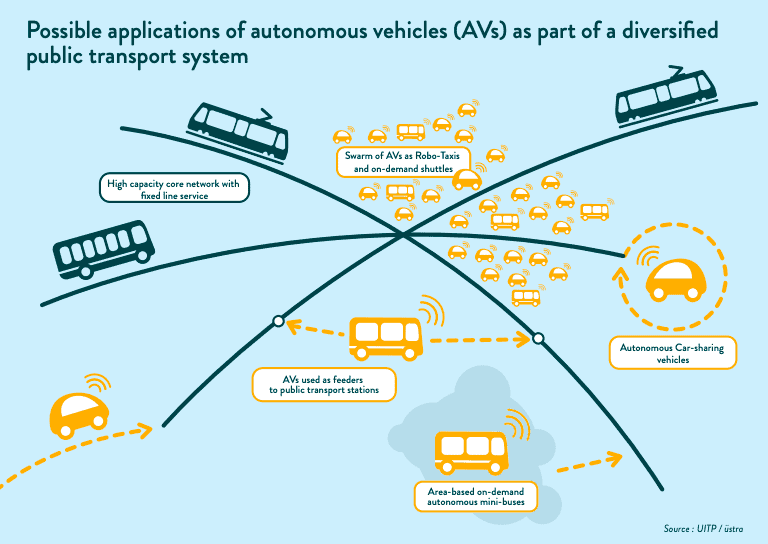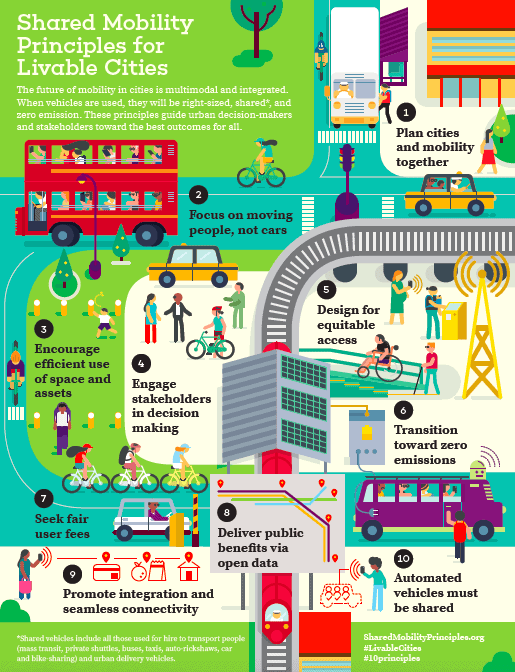With the advent of self-driving cars, urban mobility will soon reach a fork in the road. One route leads toward cities paralyzed by a sharp increase in private vehicle use. The other takes us in a different direction: one in which self-driving cars don’t cripple our streets, but actually force us to confront—and solve—some of the long-standing problems in our transportation systems.
Which route we take tomorrow depends on choices we make today. Luckily, some of transportation’s more innovative thinkers have begun drawing us a roadmap.
The Shared Mobility Principles for Livable Cities, developed in 2017 by Zipcar cofounder Robin Chase, take aim at a key dilemma presented by self-driving cars: If everyone owns an autonomous vehicle, they’ll be wildly overused—far more than the cars we currently own, which, as much as we overuse those, are parked 95 percent of the time.
Why will AVs be used more frequently than we use the cars we have now? Chase cites cameras being added to smartphones as an apt comparison.
“Remember when smartphones first came out?” she says. “You thought, what do I need this camera for?” Before smartphones, cameras were mainly for weddings, vacations, deep-sea fishing expeditions, that sort of thing. But the smartphone camera changed everything. The supply of the camera created the demand for photos. Now, we photograph every sunset, cat, dessert and airplane wing.
Something similar will happen with self-driving cars. Right now, you probably imagine your self-driving vehicle making the same trips you make today, taking you to work or shuttling your kids to school and to playdates. But what will actually happen is that you’ll be at work and you’ll notice it’s raining. Then you’ll realize you left your umbrella at home, so you’ll send your AV to your house to pick it up. Or you’ll send it across town to buy a single jar of mustard. Or—assuming it’s electric, making gas a non-issue—you’ll dispatch it to Philadelphia for a cheesesteak. There will be no incentive not to.
The result? Car use will increase exponentially, creating unprecedented congestion.
The Shared Mobility Principles, initiated by Chase in partnership with a consortium of transportation experts and NGOs, are designed to halt this calamity before it can take root. They outline ten axioms that can keep our transportation systems functional in an era of upheaval. According to Chase, it took seven months of weekly three-hour meetings to finalize them.
As the founder of Zipcar, Chase knows a thing or two about sharing, and believes that shared fleets of AVs are the best way to avert the nightmare of overuse.
“The single most expensive thing in cars is the driver—or, our personal time,” says Chase. “If you introduce AVs with that same metric, now we’ve taken out your personal time.” In other words, with driverless cars, the “personal time” cost of driving is removed, and with it, any disincentive to using that car for everything, all of the time. But if no one actually owns an AV—if they only come in shared fleets, with a user fee for each time you use one—then that personal cost, in the form of money, is put back in, preventing overuse.
“If we put self-driving cars into our current form factors—laws, streets, taxes, zoning—it’s a catastrophe,” says Chase. “That’s why it’s critical that AVs must be shared.”
To this end, the principles stipulate that AVs in dense urban areas “be part of shared fleets, well-regulated and zero emission.” This is to “discourage low-value car trips.” Such low-value trips are already gridlocking cities, as regulations struggle to catch up with Uber, Amazon and Fresh Direct. Yet today’s congestion would seem minor compared to a world with AVs ungoverned by rules. A 2017 report by public transportation coalition UITP found that the potential for AVs to have a positive or negative impact on cities hinges on their introduction as “fleets of driverless shared autonomous vehicles of different sizes reinforcing an efficient high-capacity public transport network supporting walking and cycling.”
The Shared Mobility Principles provide the foundation from which these rules can be developed, and encompass a range of precepts, from fair user fees to people-first planning to open data. Taken together, they amount to a plan that could transform our transportation system from its current state of disarray into something resembling sanity.
Already, the principles are changing how cities are planning for the era of AVs. Its signatories include the cities of Pittsburgh and Paris, as well as the New Zealand Transport Agency. The fact that major cities and transportation agencies are committing to shared fleets of self-driving cars signals a sea change in these places’ approach to transportation more broadly. Upon signing the document, Pittsburgh Mayor William Peduto said that it would allow the city to “create transportation solutions that provide an underlying foundation of sustainability and equity in the future.”

Whether Pittsburgh will stick to its commitment remains to be seen, but there’s reason to believe that it will. In 2017, to help align its transportation policies with the principles, Peduto created a new Department of Mobility and Infrastructure (DOMI), which is tasked with pursuing safer, sustainable, non-car-based transportation solutions for the city. Though DOMI isn’t specifically focused on implementing shared AV fleets, it stipulates that all trips under one mile should be “easily and enjoyably achieved by non-vehicle travel,” that streets and intersections can be intuitively navigated by an adolescent, and that every household in Pittsburgh be able to access fresh fruits and vegetables within 20 minutes of home without a private vehicle.
DOMI is an example of how planning in advance for our AV future is already showing results. “What these principles are trying to do is get ahead of the regulatory conversations that are happening in municipal, provincial and state governments around the world,” says Jeffrey Tumlin, Principal and Director of Strategy at transportation planning firm Nelson\Nygaard. “They’re trying to steer us toward the ‘heaven’ version of the heaven/hell scenario.”
In that sense, the advent of AVs is forcing us to do something long overdue: rethink how people have been getting around in dense urban areas for the better part of a century. “By having people move to per-trip payment, they are much more likely to use other modes,” says Chase. “When I look forward with optimism, I think self-driving cars will mean we can completely change the landscape of cities.”










